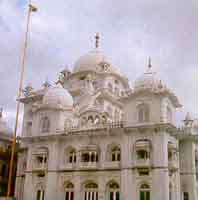| Destinations
|
|||
 A very fertile arched stretch of land along the bank of the Ganga, the history and heritage of modern day Patna go back well over two millennia. Like Delhi, Patna too had been the regal seat of governance for successive kingdoms since ancient times. Even today it is the capital city of the state of Bihar.
A very fertile arched stretch of land along the bank of the Ganga, the history and heritage of modern day Patna go back well over two millennia. Like Delhi, Patna too had been the regal seat of governance for successive kingdoms since ancient times. Even today it is the capital city of the state of Bihar.
As each ruler ascended in power and established dynastic glory, he gave his capital a new name. Thus the ancient Kusumpura metamorphosed through Pushpapura, Pataliputra, Azeemabad and now into Patna, a continuous history ranging from 6th century BC to present times - a record claimed by few cities in the world. It was Ajatshatru the Magadha king who first built a small fort in Pataligram on the bank of the Ganga in the 6th century BC, which later blossomed into the ancient glory still to be seen in the neighbouring archaeological sites at Kumrahar, Bhiknapahari, Agamkuan, Bulandi Bagh and Kankar Bagh. Pataliputra dominated the political fortunes of the whole of north India between 6th century BC and 5th century AD, a fact established by archaeological excavations. After centuries of being eclipsed, Sher Shah Suri returned the city to its former glory and established the present Patna in the 16th century. |
More on Bihar • Overview • Arts & Crafts • Wildlife sanctuaries • Fairs & Festivals • Buddhist Sites Cities • Ranchi • Hazaribagh • Netarhat • Jamshedpur • Damodar Valley • Dhanbad • Bhagalpur • Monghyr
Travelogues Leisure • Wild life • Heritage • Pilgrimage |
||
After the decline of the Mughals, the British too found Patna a convenient regional capital and built a modern extension to this ancient city and called it Bankipore. It was in Gandhi Maidan in this area that Mahatma Gandhi held his prayer meetings.
Kumrahar Golghar Har Mandir Takht Martyr's Memorial Pathar Ki Masjid Sher Shah Suri Masjid Khuda Baksh Oriental Library Patna Museum Jalan Museum Sadaqat Ashram Maner Other places of interest near Patna Padri ki Haveli - an 18th century catholic church. Biological Park - a zoo cum botanical garden. Patna Yoga Vidyalaya - The Patna School of Yoga famed for excellence in Yoga teaching. How to get there Where to stay
Information: Courtesy Government of India
|
|||
Editor: Romola Butalia (c) India Travelogue. All rights reserved. |
|||
